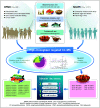Diet-Related Lipidomic Signatures and Changed Type 2 Diabetes Risk in a Randomized Controlled Feeding Study With Mediterranean Diet and Traditional Chinese or Transitional Diets
- PMID: 37463495
- PMCID: PMC10465987
- DOI: 10.2337/dc23-0314
Diet-Related Lipidomic Signatures and Changed Type 2 Diabetes Risk in a Randomized Controlled Feeding Study With Mediterranean Diet and Traditional Chinese or Transitional Diets
Abstract
Objective: Few trials studied the links of food components in different diets with their induced lipidomic changes and related metabolic outcomes. Thus, we investigated specific lipidomic signatures with habitual diets and modified diabetes risk by using a trial and a cohort.
Research design and methods: We included 231 Chinese with overweight and prediabetes in a randomized feeding trial with Mediterranean, traditional, or transitional diets (control diet) from February to September 2019. Plasma lipidomic profiles were measured at baseline, third month, and sixth month by high-throughput targeted liquid chromatography-mass spectrometry. Associations of the identified lipids with habitual dietary intakes were examined in another lipidomic database of a Chinese cohort (n = 1,117). The relationships between diet-induced changes of lipidomic species and diabetes risk factors were further investigated through both individual lipids and relevant modules in the trial.
Results: Out of 364 lipidomic species, 26 altered across groups, including 12 triglyceride (TAG) fractions, nine plasmalogens, four phosphatidylcholines (PCs), and one phosphatidylethanolamine. TAG fractions and PCs were associated with habitual fish intake while plasmalogens were associated with red meat intake in the cohort. Of the diet-related lipidomic metabolites, 10 TAG fractions and PC(16:0/22:6) were associated with improved Matsuda index (β = 0.12 to 0.42; PFDR < 0.030). Two plasmalogens were associated with deteriorated fasting glucose (β = 0.29 to 0.31; PFDR < 0.014). Similar results were observed for TAG and plasmalogen related modules.
Conclusions: These fish- and red meat-related lipidomic signatures sensitively reflected different diets and modified type 2 diabetes risk factors, critical for optimizing dietary patterns.
© 2023 by the American Diabetes Association.
Conflict of interest statement
Figures


References
-
- American Diabetes Association Professional Practice Committee . 2. Classification and diagnosis of diabetes: Standards of Medical Care in Diabetes-2022. Diabetes Care 2022;45(Suppl. 1):S17–S38 - PubMed
Publication types
MeSH terms
Substances
LinkOut - more resources
Full Text Sources
Medical

